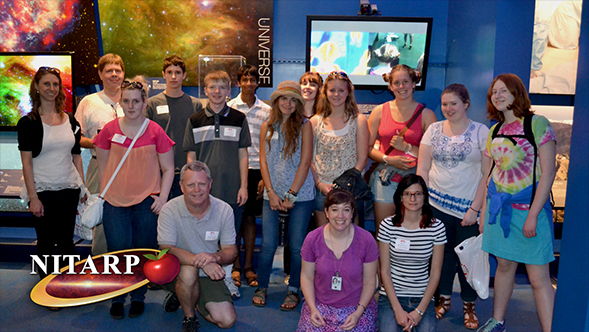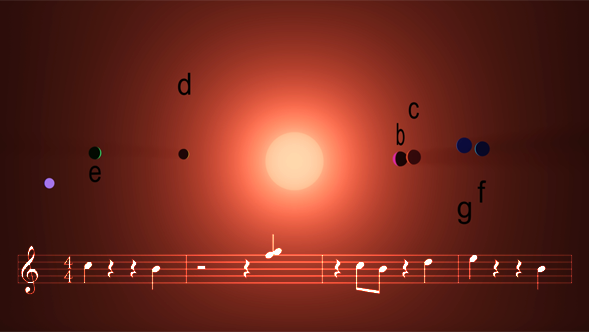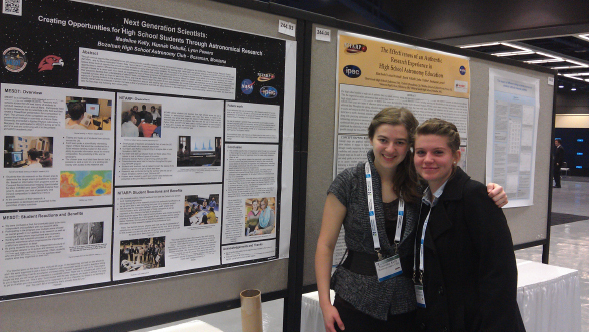
By Luisa Rebull | August 28th, 2015
When stars eat planets, are they messy eaters? Do they leave any crumbs? Our upcoming refereed journal article describes our new research done on this topic – done with high school students!
My NITARP team from last year had a very interesting project, one that will appear soon as a refereed article in the Astronomical Journal! Not all research done by anyone, anywhere gets turned into journal articles; there are a lot of “dead ends” as we struggle to figure out what the right answer is. In 10 years of doing authentic research with high school teachers and students, this is the 6th team whose work has produced a journal article.
There are many planets that we know of that are close enough to their host stars that they will get eaten when their star becomes a giant. As low-mass stars run out of hydrogen (H) to turn into helium (He) in their cores, they experience several major changes, not the least of which is that they get a lot bigger and rotate a lot slower, so planet ingestion must happen. But, will that planet ingestion process leave any observable signatures? People have been looking for this for several years, and there are some models that say that planet ingestion will cause the star to have fast rotation, much more lithium (Li) than other similar stars, and much more infrared (IR) light than other similar stars. This so-called “IR excess” is interpreted as a dusty ring, disk, or shell that is ejected during planet ingestion – ‘crumbs’ from eating the planet. Our NITARP team set out to explore this relationship, and our team was called Hungry Giants - WISE Excesses and Lithium Study (HG-WELS).
We had 316 targets that were thought to be K-type giants that are becoming giants for the first time (“first ascent”) and therefore may be in the process of ingesting planets. When we started, we planned to examine our targets with IR data from the WISE telescope, which is newer (and therefore more sensitive and with higher spatial resolution) than previous data that had been used. We thought that it would be relatively simple and straightforward to go and get the WISE data for these targets, look for what we thought would be many IR excesses, and then explore the relationship between IR excess, rotation, and Li abundance. It did not work out quite that way!
The sky can look very different in different wavelengths of light, so sometimes it is hard to say with certainty that “this bright infrared source” is the same as “that bright optical source.” Sometimes “this bright infrared source” is actually the same as “that unbelievably faint optical source.” When you have images of the same source from many different surveys covering a wide range in wavelengths (in this case, 0.5-100 microns), it makes it very much easier to identify sources that are bright at, say, 20 microns and securely find the same source in all the other wavelengths, even if that same source is in fact very faint in the optical (0.5 microns).
To this end, the HG-WELS team used many tools and data found at IRSA; indeed, the tools and data access at IRSA made this project possible. One of the IRSA tools we used is called FinderChart, which pulls image and catalog data simultaneously from several different surveys. FinderChart enabled us to quickly, efficiently, and interactively explore images from 5 different surveys at once. As a result, one of our big discoveries was that, in 24 cases, the source of the IR is not likely to be the optically bright K giant at all!
After we could match the sources across all the surveys, for the rest of the ‘easier’ sources, we got the quantitative measures of the brightnesses of the sources by using an automatic catalog matching feature in the IRSA Catalog Search tool, and explored data from essentially all of the large surveys at IRSA: WISE, Spitzer (SEIP), 2MASS, MSX, AKARI, IRAS PSC & FSC, DENIS, and SDSS. The fact that FinderChart is interactive made is possible for us to identify the source catalog match for stars that move too much between frames for automatic catalog matching to work (those with high proper motion), and things that are super bright (saturated, where the object might not appear in the catalog at all). After we had the brightness measures from the catalogs, we could look for IR excesses.
In the end, we only found plausible IR excesses around 28 of our K giants, which was a far smaller number than we expected going into this. But some of the biggest IR excesses were around the fastest rotators with the most lithium! It could be that, if planet ingestion really does cause all these effects, that any ejected dust does not last very long, so we have to be looking at exactly the right time to catch it in the act. Or, planet ingestion only creates dust when the conditions are exactly right (rotating above a threshold? Eating a big enough planet?). Or the few objects we found with very large IR excesses may not be giant stars at the end of their lives at all, but rather giant stars that are very young, on their way to burning hydrogen on the main sequence. Young stars often have fast rotation, lots of lithium, and very large IR excesses.
As is so often the case, our work has led to more questions, and we will need more data to answer them! But in the meantime, our work will live on in our journal article. Our author list includes all the teachers and students who contributed substantially to the work being presented.
Rebull, L., Carlberg, J., Gibbs, J., Deeb, J. E., Larsen, E., Black, D., Altepeter, S., Bucksbee, E., Cashen, S., Clarke, M., Datta, A., Hodgson, E., and Lince, M., 2015, AJ, in press, (arXiv:1507.00708).
You can explore the FITS images yourself for our targets from POSS, SDSS, 2MASS, WISE, and IRAS! Go to FinderChart, and upload this target list in the “multiple positions” tab.
 Making Music from Exoplanets
Making Music from Exoplanets
 Next-Generation Scientists: Creating Opportunities for High School Students Through Astronomical Research
Next-Generation Scientists: Creating Opportunities for High School Students Through Astronomical Research



